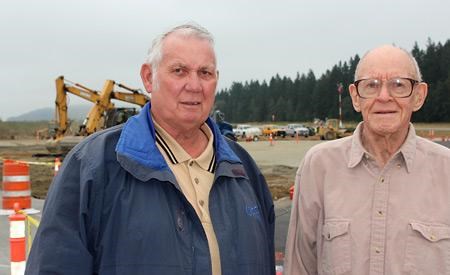VIDEO – Two concerned residents want the City of Powell River to stop hauling fill from the airport construction project to the east end of the runway, the site of an old landfill.
Herb Gawley and Jack Dice raised concerns about the site in 1995, when the city dumped garbage from the old Squatters Creek landfill at the airport. Myrtle Creek is located about 60 metres downslope of the dump site and numerous shallow private drinking water wells supply nearby homes.
The city is using the site now to stockpile dirt from the construction project at the airport. “They’re burying it,” said Gawley. “This is nothing but a cover-up. That’s what it is.”
Dice said contamination leaches out of the pile and is washed down to the creek. “They’ve been told to have closure,” said Dice. “Their closure is piling dirt on top.”
The airport landfill is one of the old landfills listed in Powell River Regional District’s solid waste management plan, which is still with the provincial government waiting for ministerial approval. It calls for a closure plan to be prepared in 2012.
The garbage is still in the ground at the airport, Dice said. “As long as the garbage is higher than the creek, everything goes downhill,” he said. “The garbage should be taken out.”
The east end of the airport had been used as a landfill for incinerator bottom ash from 1971 to 1988 and after that for fill material, primarily soil from excavations.
Before 1971, the municipality used portions of Squatters Creek, which used to flow through Westview, as a landfill by forcing water to flow through culverts and dumping garbage in the creek’s gully.
In 1995, the culvert under Duncan Street collapsed after a heavy rainfall. Municipal crews dug a large hole to repair the pipe. By mistake, some of the garbage from the old Squatters Creek landfill was trucked up to the airport site, instead of to the waste transfer station where it was supposed to go.
Officials estimated two to three cubic metres of garbage ended up at the airport, but Gawley and Dice always disputed that claim, saying it was much more. Gawley filmed the airport site, as well as the large hole on Duncan. His video shows a variety of garbage, including tin cans, bottles, pill containers, oil cans, chemical containers, an automobile battery and various other articles, as well as mud and debris sliding down into the creek.
Municipal workers picked out some of the garbage to prepare for a visit from a ministry of environment official, who said, after he inspected the site, that there was no garbage there. But Gawley’s film shows people digging away and exposing the trash. They even dug out a big bundle of newspapers from Colorado.
“If it hadn’t been for Herb taking that tape, we wouldn’t be here today talking,” said Dice. “Otherwise, it would have been dead.”
Officials did investigate the issue and completed a preliminary assessment of potential health risks. They concluded that the airport landfill did not appear to have adversely affected the water quality of domestic drinking water wells or Myrtle Creek. They did recommend, however, that the municipality implement a one-year intensive water quality monitoring program to obtain baseline water quality data.
Now, both Gawley and Dice want the city to stop hauling dirt to the airport landfill and take away what has been placed there. They also want the city to produce the closure site for the landfill. “It’s sickening to do something that you can’t recover from,” Dice said. “They say tomorrow water is going to be more important than oil. It was good water. Why are we wrecking it?”
Tor Birtig, the city’s manager of operational services, said he doesn’t have “any grave concerns, otherwise we wouldn’t have done it. It’s definitely not a cover-up. Every agency that I’m aware of that should know, does know about it.”
Dan Glover, Vancouver Coastal Health’s environmental protection officer, has inspected the site, Birtig said. “He didn’t see an issue.”
Glover suggested more tests should be taken, in order to compare with testing that had been done in the past, said Birtig. “We are going to do that. It will help with a baseline for the closure plan.”
The city plans to seed grass in the area, to lower maintenance costs, and to create a safe run-out from the end of the runway, explained Birtig.



